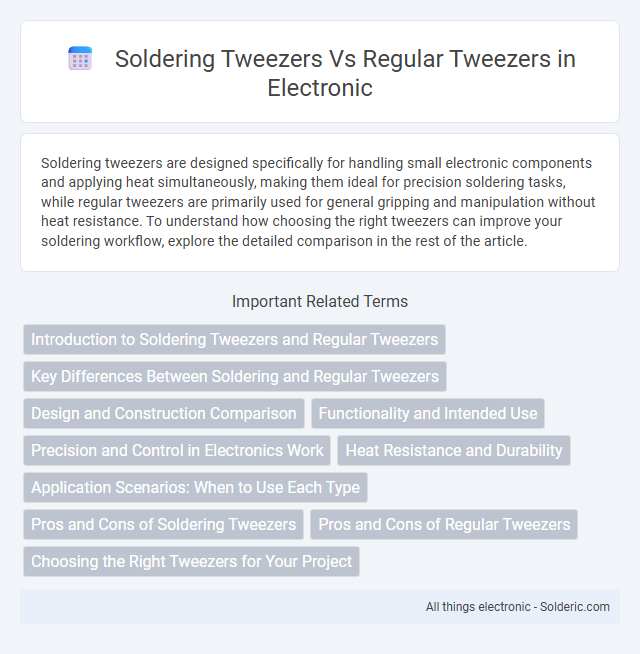Soldering tweezers are designed specifically for handling small electronic components and applying heat simultaneously, making them ideal for precision soldering tasks, while regular tweezers are primarily used for general gripping and manipulation without heat resistance. To understand how choosing the right tweezers can improve your soldering workflow, explore the detailed comparison in the rest of the article.
Comparison Table
| Feature | Soldering Tweezers | Regular Tweezers |
|---|---|---|
| Primary Use | Desoldering and soldering small electronic components | Gripping, picking, and handling small objects |
| Heating Capability | Heated tips for melting solder | No heating element |
| Material | Heat-resistant metals and insulated handles | Stainless steel or plastic |
| Tip Design | Conductive, often replaceable tips | Non-conductive, pointed or flat tips |
| Application | Surface-mount device (SMD) manipulation and soldering | General-purpose precision tasks |
| Price Range | Higher cost due to electronic components | Lower cost, simple mechanical tool |
| Skill Required | Intermediate to expert soldering skills | Basic handling skills |
Introduction to Soldering Tweezers and Regular Tweezers
Soldering tweezers feature dual heated tips designed for precise melting and removal of surface mount components, making them indispensable in electronics repair and assembly. Regular tweezers lack heating elements and serve primarily for gripping and manipulating small objects without applying heat. Understanding these fundamental differences aids in selecting the right tool for tasks involving delicate electronic components versus general handling needs.
Key Differences Between Soldering and Regular Tweezers
Soldering tweezers feature dual heated tips designed specifically for precision melting of solder on small electronic components, while regular tweezers are non-heated and intended for general-purpose gripping and handling. The key difference lies in the soldering tweezers' ability to maintain consistent heat at controlled temperatures, enabling efficient surface-mount device (SMD) rework and desoldering. Regular tweezers lack temperature control and heating elements, making them unsuitable for tasks requiring thermal application.
Design and Construction Comparison
Soldering tweezers feature a specialized design with built-in heating elements and insulated handles, enabling precise control and efficient heat transfer for soldering tasks. Regular tweezers, constructed from stainless steel or similar metals, lack heating capabilities and are crafted primarily for gripping and manipulating small components. Your choice depends on whether you require temperature control for electronics work or simple precision handling.
Functionality and Intended Use
Soldering tweezers are designed for precise heat application to remove or place surface-mount components, featuring dual heated tips that enable simultaneous contact with both ends of components. Regular tweezers serve general-purpose tasks such as gripping small parts or manipulating delicate objects without heat functionality. Your choice depends on whether you need heat for soldering tasks or simply require precision handling of tiny components.
Precision and Control in Electronics Work
Soldering tweezers provide enhanced precision and control in electronics work with their heat-resistant tips designed specifically for handling small components during soldering tasks. Regular tweezers lack temperature tolerance, making them less suitable for manipulating delicate electronic parts without risking damage. Using soldering tweezers improves your accuracy and efficiency, especially when dealing with surface-mount devices (SMD) and tight circuit layouts.
Heat Resistance and Durability
Soldering tweezers feature heat-resistant tips made from materials like stainless steel or ceramic, allowing them to withstand high temperatures without deforming or losing precision. Regular tweezers, often crafted from standard metals or plastic, lack this heat resistance and can warp or degrade when exposed to soldering heat. Choosing soldering tweezers ensures durability and safety when handling hot components, protecting your tools and improving your work quality.
Application Scenarios: When to Use Each Type
Soldering tweezers excel in precision tasks involving surface mount components (SMD) and delicate electronics repair, offering controlled heat application for component removal and repositioning. Regular tweezers are ideal for general handling, assembly, and inspection tasks where heat is unnecessary, such as placing small parts or handling wires. Choosing between the two depends on whether the job requires heat for soldering or simple mechanical manipulation without risk of thermal damage.
Pros and Cons of Soldering Tweezers
Soldering tweezers provide precise heat application for small electronic components, making them ideal for surface-mount device (SMD) rework and repair, with the advantage of reducing the risk of thermal damage to adjacent parts. They offer temperature control and dual-tip heating, but their cost and learning curve can be higher compared to regular tweezers. However, regular tweezers excel in manual precision handling without heat, making them suitable for general electronic assembly but ineffective for soldering tasks.
Pros and Cons of Regular Tweezers
Regular tweezers offer precise control and are lightweight, making them ideal for delicate electronic components and fine wire manipulation during soldering tasks. However, they lack integrated heating elements, which limits efficiency compared to soldering tweezers when it comes to simultaneous holding and soldering of components. Their non-heated tips also increase the risk of cold joints and extended repair times in surface-mount device (SMD) rework processes.
Choosing the Right Tweezers for Your Project
Soldering tweezers offer precise control and heat resistance essential for electronics and delicate soldering tasks, unlike regular tweezers which lack thermal insulation and fine tips. Your project demands the right tool: soldering tweezers help prevent component damage by evenly distributing heat, ideal for surface-mount devices (SMD) or rework jobs. Selecting tweezers with ergonomic design and appropriate tip size ensures accuracy and comfort during extended soldering sessions.
soldering tweezers vs regular tweezers Infographic

 solderic.com
solderic.com